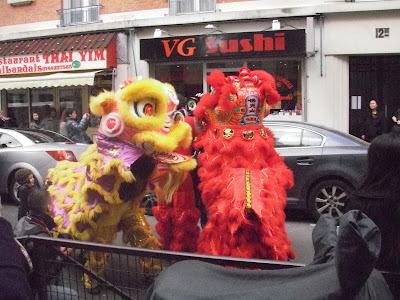I'm sure you've been all desperately wondering what I've been up to since I last posted about my
weekend in Reims two weekends ago, so apologies for not filling you all in sooner. I've actually been back to England for a while. I stayed with my girlfriend, spent some time at home and visited my university town of Bristol for the first time since last June.
I'm now back in France and this post continues the theme of visits to fine French historical buildings with a trip to the Palace of Versailles.
I don't suppose
the palace needs a whole lot of introduction, but just in case it became the main residence of the French monarchy during the reign of
Louis XIV. Louis decided to build himself a magnificent palace on the site of an old hunting lodge at Versailles, conveniently close to Paris but distant enough for Louis to stamp his own mark on the royal court.
The palace reached its peak of grandeur and importance during Louis XIV's reign, and was the home of the French royal family until 1789, when the events of the Revolution forced Louis and his family to relocate to the Tuileries Palace.
Since then, it has changed hands several times during France's immensely confusing post-Revolution history, in which France has been a republic (several times), an empire, a partly-occupied territory and a monarchy. Now that France is a settled republic, the chateau and its grounds are now a gigantic museum.
 |
| The Hall of Mirrors |
You can only look around a small part of the palace following a set route. I guess this is because the palace is so huge that visitors would get lost if they were allowed to wander through the
seven hundred rooms as they wished. The route you take gives you its first "wow" moment with the palace's most famous room:
the Hall of Mirrors. Louis XIV used this room to entertain courtiers and guests, and it's easy to see why. The entire room is a monument to Louis's power and wealth - the central painting on the ceiling is entitled
le roi gouverne par lui-même (the king governs by himself).
 |
| Peeking behind the royal covers |
This next picture is of Louis's XIV royal bed. The king was woken up by an attendant at around 7:30 a.m. and was washed and dressed. Incredibly, he was watched through all this by a few close friends and courtiers. No lie-ins for His Majesty. The rest of the royal day was planned with equal care. Louis XV and Louis XVI unsurprisingly hated the suffocating precision of the royal day, and the
Levee became less frequent.
This is the Queen's bedroom. Note the little door to the left of the bed: Marie Antoinette escaped through this door during the Revolution, when a mob of Versailles women stormed the palace demanding bread to eat.
 |
| The rear facade of the palace |
I could go on with more pictures, but I think that's about enough on the palace. Next up is the Grand Trianon, the Petit Trianon, the gardens and Marie Antoinette's model village, which will come soon. Bye for now.












